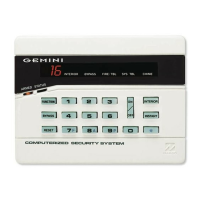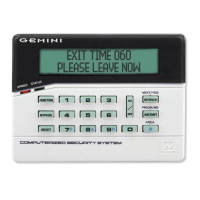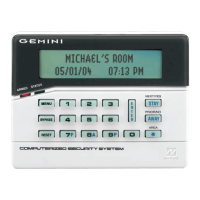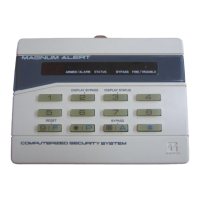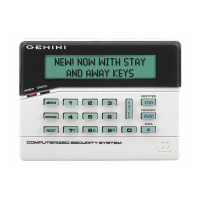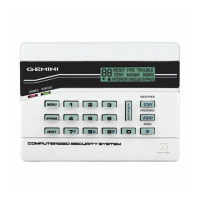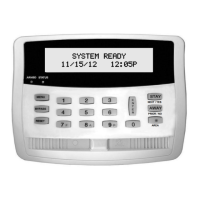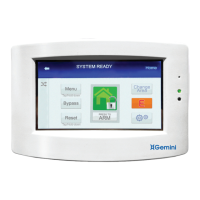Do you have a question about the NAPCO RPXP6GT and is the answer not in the manual?
Details the features of the XP-600 control panel, including zones, keypads, and wiring.
Outlines the communication capabilities of the XP-600, such as telephone numbers and reporting formats.
Specifies the electrical current and voltage requirements for the XP-600 system.
Details the voltage and current characteristics for system loops and devices.
Lists key device limits, dimensions, weight, and operating temperature.
Lists smoke detectors certified for compatibility with the XP-600 system.
Provides details on ordering the XP-600 panel, keypads, and optional accessories.
Details the certifications and compliance standards met by the XP-600 system.
Instructions on how to reset the XP-600 panel to its factory default settings.
Guidance on programming the system directly through the keypad interface.
Steps for downloading software and programming via a local connection.
Steps for downloading software and programming remotely over phone lines.
Steps for physically mounting the XP-600 control panel and keypads.
Recommendations for installing smoke detectors in fire protection systems.
Comprehensive instructions for connecting various components of the XP-600 system.
Specific wiring instructions for burglary and fire zones, including doubling resistors.
Details on wiring the Programmable Output (PGM) for custom functions.
Interpretation of the status indicators (LEDs) on the keypad.
Procedures for arming the security system in various modes, including instant arming.
Steps for disarming the security system and clearing alarms.
How to arm and disarm the system using keyfobs or keyswitches.
How zones are automatically bypassed based on system arming modes.
Procedures for manually bypassing individual zones or groups of zones.
Instructions for entering and navigating the user programming mode.
Commands available for users to control system functions like Bell Test and Chime.
Commands specific to dealer operations, including downloading and system tests.
How to check the signal strength of wireless transmitters using the keypad.
Enables logging of wireless transmitter signal strength for troubleshooting.
Defines zones that allow for entry or exit delays without triggering an immediate alarm.
Zones that automatically bypass if exit delay is not violated, offering flexibility.
Zones that require an Exit/Entry zone to be violated before they cause an alarm.
Zones that automatically bypass during exit delay if not violated, simplifying arming.
Configures the time allowed for exiting the premises after arming the system.
Configures the time allowed for entering and disarming the system.
Settings for detecting phone line cuts and monitoring wireless transmitter activity.
Adjusts the timing for system test reports sent to the central station.
Customizes keypad behavior, including panic alarms, urgency indicators, and beeps.
Configures the PGM output for audio verification and access control.
Configures the PGM output for fire, auxiliary, panic, and test timer events.
Configures the PGM output for AC failure, low battery, trouble, and armed status.
Programming the primary telephone number for system reporting.
Selecting the data format and options for communicating with receivers.
Configuring communicator behavior, including dialing methods and backup reporting.
Configuring the system to send alarm data to pagers, including subscriber IDs.
Programming a third telephone number for reporting or backup.
Defining specific codes for various system events and zones.
Configuring reports for specific closing or opening scenarios, like bypassed zones.
Assigning wireless transmitter RF IDs to specific system zones.
Customizing keyfob functions, including arming, disarming, and auxiliary actions.
Configuring phone numbers and ring counts for remote downloading.
Details on using ring method, answering machine override, and command downloads.
Setting up automatic system downloads using PC-based software.
Setting and managing dealer codes and user access codes.
Adjusting system behavior through dealer-specific options and settings.
Configuring the number of attempts the system makes to connect before reporting failure.
How to access and interpret system trouble indicators on the keypad.
Configuring which system troubles are reported to the central station.
Addresses issues related to the bell output, buzzing, and supervision circuits.
Solutions for removing keypad sounders on alarm or managing chime functions.
Explains how to assign chime functionality to specific zones.
Troubleshooting continuous piezo buzzing and PGM output pulsing.
Information on panel fuses and why bell trouble might not be indicated.
Resolving issues with wireless transmitters not responding and keypad display problems.
Details the features of the XP-600 control panel, including zones, keypads, and wiring.
Outlines the communication capabilities of the XP-600, such as telephone numbers and reporting formats.
Specifies the electrical current and voltage requirements for the XP-600 system.
Details the voltage and current characteristics for system loops and devices.
Lists key device limits, dimensions, weight, and operating temperature.
Lists smoke detectors certified for compatibility with the XP-600 system.
Provides details on ordering the XP-600 panel, keypads, and optional accessories.
Details the certifications and compliance standards met by the XP-600 system.
Instructions on how to reset the XP-600 panel to its factory default settings.
Guidance on programming the system directly through the keypad interface.
Steps for downloading software and programming via a local connection.
Steps for downloading software and programming remotely over phone lines.
Steps for physically mounting the XP-600 control panel and keypads.
Recommendations for installing smoke detectors in fire protection systems.
Comprehensive instructions for connecting various components of the XP-600 system.
Specific wiring instructions for burglary and fire zones, including doubling resistors.
Details on wiring the Programmable Output (PGM) for custom functions.
Interpretation of the status indicators (LEDs) on the keypad.
Procedures for arming the security system in various modes, including instant arming.
Steps for disarming the security system and clearing alarms.
How to arm and disarm the system using keyfobs or keyswitches.
How zones are automatically bypassed based on system arming modes.
Procedures for manually bypassing individual zones or groups of zones.
Instructions for entering and navigating the user programming mode.
Commands available for users to control system functions like Bell Test and Chime.
Commands specific to dealer operations, including downloading and system tests.
How to check the signal strength of wireless transmitters using the keypad.
Enables logging of wireless transmitter signal strength for troubleshooting.
Defines zones that allow for entry or exit delays without triggering an immediate alarm.
Zones that automatically bypass if exit delay is not violated, offering flexibility.
Zones that require an Exit/Entry zone to be violated before they cause an alarm.
Zones that automatically bypass during exit delay if not violated, simplifying arming.
Configures the time allowed for exiting the premises after arming the system.
Configures the time allowed for entering and disarming the system.
Settings for detecting phone line cuts and monitoring wireless transmitter activity.
Adjusts the timing for system test reports sent to the central station.
Customizes keypad behavior, including panic alarms, urgency indicators, and beeps.
Configures the PGM output for audio verification and access control.
Configures the PGM output for fire, auxiliary, panic, and test timer events.
Configures the PGM output for AC failure, low battery, trouble, and armed status.
Programming the primary telephone number for system reporting.
Selecting the data format and options for communicating with receivers.
Configuring communicator behavior, including dialing methods and backup reporting.
Configuring the system to send alarm data to pagers, including subscriber IDs.
Programming a third telephone number for reporting or backup.
Defining specific codes for various system events and zones.
Configuring reports for specific closing or opening scenarios, like bypassed zones.
Assigning wireless transmitter RF IDs to specific system zones.
Customizing keyfob functions, including arming, disarming, and auxiliary actions.
Configuring phone numbers and ring counts for remote downloading.
Details on using ring method, answering machine override, and command downloads.
Setting up automatic system downloads using PC-based software.
Setting and managing dealer codes and user access codes.
Adjusting system behavior through dealer-specific options and settings.
Configuring the number of attempts the system makes to connect before reporting failure.
How to access and interpret system trouble indicators on the keypad.
Configuring which system troubles are reported to the central station.
Addresses issues related to the bell output, buzzing, and supervision circuits.
Solutions for removing keypad sounders on alarm or managing chime functions.
Explains how to assign chime functionality to specific zones.
Troubleshooting continuous piezo buzzing and PGM output pulsing.
Information on panel fuses and why bell trouble might not be indicated.
Resolving issues with wireless transmitters not responding and keypad display problems.
| Display | LCD |
|---|---|
| Keys | 16 |
| Backlight | Yes |
| Compatibility | NAPCO Gemini Security Systems |
| Communication | Wireless |


